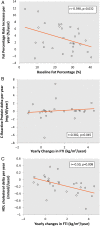Fat tissue and inflammation in patients undergoing peritoneal dialysis
- PMID: 27274820
- PMCID: PMC4886903
- DOI: 10.1093/ckj/sfw007
Fat tissue and inflammation in patients undergoing peritoneal dialysis
Abstract
Background: Body weight has been increasing in the general population and is an established risk factor for hypertension, diabetes, and all-cause and cardiovascular mortality. Patients undergoing peritoneal dialysis (PD) gain weight, mainly during the first months of treatment. The aim of this study was to assess the relationship between body composition and metabolic and inflammatory status in patients undergoing PD.
Methods: This was a prospective, non-interventional study of prevalent patients receiving PD. Body composition was studied every 3 months using bioelectrical impedance (BCM(®)). We performed linear regression for each patient, including all BCM(®) measurements, to calculate annual changes in body composition. Thirty-one patients in our PD unit met the inclusion criteria.
Results: Median follow-up was 26 (range 17-27) months. Mean increase in weight was 1.8 ± 2.8 kg/year. However, BCM(®) analysis revealed a mean increase in fat mass of 3.0 ± 3.2 kg/year with a loss of lean mass of 2.3 ± 4.1 kg/year during follow-up. The increase in fat mass was associated with the conicity index, suggesting that increases in fat mass are based mainly on abdominal adipose tissue. Changes in fat mass were directly associated with inflammation parameters such as C-reactive protein (r = 0.382, P = 0.045) and inversely associated with high-density lipoprotein cholesterol (r=-0.50, P = 0.008).
Conclusions: Follow-up of weight and body mass index can underestimate the fat mass increase and miss lean mass loss. The increase in fat mass is associated with proinflammatory state and alteration in lipid profile.
Keywords: fat mass; inflammation; metabolic syndrome; peritoneal dialysis.
Figures



References
-
- Escribano Garcia S, Vega Alonso AT, Lozano Alonso J et al. . Obesity in Castile and Leon, Spain: epidemiology and association with other cardiovascular risk factors. Rev Esp Cardiol 2011; 64: 63–66 - PubMed
-
- Adams KF, Schatzkin A, Harris TB et al. . Overweight, obesity, and mortality in a large prospective cohort of persons 50 to 71 years old. N Engl J Med 2006; 355: 763–778 - PubMed
-
- Fernstrom A, Hylander B, Moritz A et al. . Increase of intra-abdominal fat in patients treated with continuous ambulatory peritoneal dialysis. Perit Dial Int 1998; 18: 166–171 - PubMed
-
- Glanton CW, Hypolite IO, Hshieh PB et al. . Factors associated with improved short term survival in obese end stage renal disease patients. Ann Epidemiol 2003; 13: 136–143 - PubMed
LinkOut - more resources
Full Text Sources
Other Literature Sources
Research Materials
Miscellaneous

